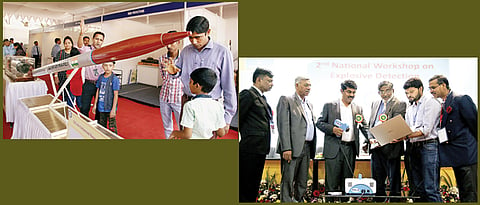

PUNE: The High Energy Materials Research Laboratory (HEMRL), Pune-based DRDO laboratory and Indian Institute of Science (IISc), Bengaluru, have jointly developed a new explosive detection device named as Raider-X, used to identify a wide range of explosives.
Raider-X was launched by Dr Satheesh Reddy, Secretary DD R&D and Chairman DRDO, on Sunday, during the 2nd National Workshop on Explosive Detection (NWED-2020) at Dr APJ Abdul Kalam Golden Jubilee Auditorium, on Pashan Road.
According to officials, the workshop is being attended by 250 delegates from DRDO labs, Army, CRPF, CISF, BDDS, police, academic institutes, industry and other security agencies. It provides a platform to scientists, technocrats and users to share knowledge, experience and technological advancements made in the recent past.
The device is capable of detecting concealed explosives using Raman Spectroscopy-based technique UMARS (Universal Multiple Angle Raman Spectroscopy) from a stand-off distance. The data library can be built in the system to expand its capability to detect a number of explosives in pure form as well as with the contaminants.
Dr Siva Umapathy, Director IISER, Bhopal, who developed the Raider-X, told Sakal Times, “At present the device can detect 20 explosives when the laser is fired from a distance of about 2 metres. The details of about 500 explosives, narcotics substance etc can be fed in its library and also the stand-off distance will be increased later. The device is handy and it can be carried in a backpack too.” In his keynote address, Dr Umapathy said serious research on explosive detection technology in academia started only a decade ago in India and is fast expanding.
“No single technology would suffice to detect all types of explosives. Hence scientists should think of amalgamation of two or three technologies and come out with devices to provide a comprehensive solution,” Dr Umapathy said.
Maharashtra Anti-Terrorism Squad (ATS) DIG Jayant Naiknavare highlighted the need of indigenous development of versatile explosive detection devices. “We need explosive detectors to be made available to the security agencies for countering the threats faced by the forces in Maoist-affected areas. The device should be efficient, quick and able to detect explosives from a distance for safety of our personnel. The quick identification of explosive will also help us in zeroing in on signature of terrorist groups,” Naiknavare said.
HEMRL Director KPS Murthy stated there is a need to come out with standard protocols for evaluation of detectors. He said that earlier, HEMRL developed an Explosive Detection Kit (EDK) based on colorimetry and is being used extensively by security and investigative agencies in India. He said the transfer of technology (ToT) of Explosive Detection Kit (EDK) was given to USA.
Scientists from renowned institutes and universities will present and share research work on detection of explosives during the workshop on March 2 to evolve a roadmap for futuristic development of detection technologies.
SYNERGY REQUIRED FOR BETTER RESEARCH
During the inaugural address, Dr Reddy stated that with increasing terrorist activities, detection of explosives became the compelling need of the hour. “Security agencies are continuously suffering from Naxal attacks. To effectively thwart the attempts of these anti-social elements, academia, DRDO and other scientific institutes must focus on explosive detection in both bulk and trace forms,” he said.
Later, while interacting with reporters, Dr Reddy said four DRDO laboratories - HEMRL, Laser Science and Technology Centre (LASTEC), Solid State Physics Laboratory (SSPL) and Defence Research and Development Establishment, Gwalior - are working in this field.
“A steering committee will be formed after this workshop to deliberate on who will do what and how to go about financial aspects. There will be periodic reviews. This will make sure there are concerted and focused efforts along with bringing together the resources and finances.”
‘MORE LIVES LOST DUE TO MINES’
- PK Mehta, Director General, Armament & Combat Engineering Systems (ACE), Pune, said that more lives of soldiers are lost due to mines than in war.
- Mehta emphasised that concerted efforts have to be made for development of devices for detection of concealed explosives.
- Dr Reddy said that ground penetrating radar has been developed for detection of mines.
